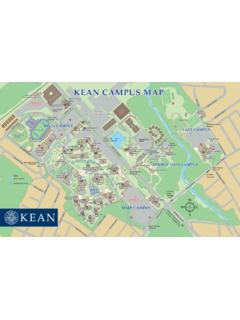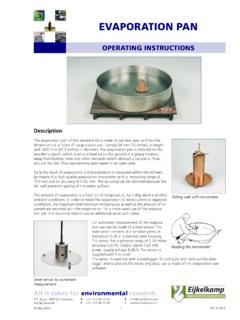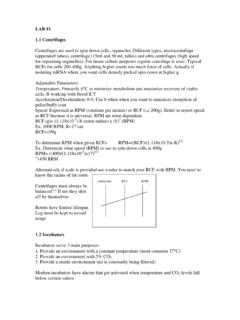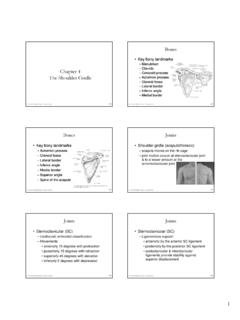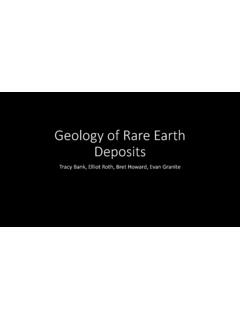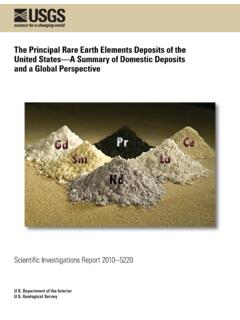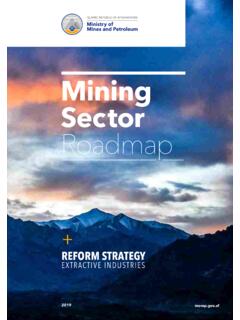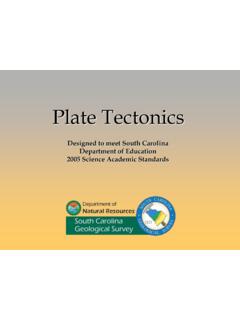Transcription of Rocks & Minerals - Kean University
1 Rocks & MineralsIntroductionAtoms & ElementsMineralsIgneous RocksSedimentary RocksMetamorphic RocksThe Rock CycleGeology of Mineral ResourcesSummaryThis curious world we inhabit is more wonderful than convenient; morebeautiful than it is useful; it is more to be admired and enjoyed than David ThoreauMy words are tied in one, with the great mountains, with the great Rocks ,with the great trees, in one with my body, and my Indian Prayer2 Introduction Understanding the composition of Rocks on other planetsprovides clues to the geologic development of thoseplanets. Rocks analyzed during NASA's Pathfinder expedition toMars were found to be similar to common Rocks on NASA s Pathfinder spacecraft landed on Mars on July4, 1997, it released a "rover," a small vehicle called Sojourner(Fig. 1). Sojourner spent the next few days getting up close andpersonal with several big Rocks around the landing site.
2 Whytravel 100,000,000 miles to look at Rocks ? Scientists knew thatthe best way to learn about Mars was to understand its mostbasic components, the Rocks that made up the planet. Therocks, and the Minerals they contain, provided clues to theevolution of were surprised to learn that the first rock theyanalyzed, nicknamed Barnacle Bill, contained many of thesame Minerals that were common on earth . The rockcomposition was similar to andesite, a rock formed byvolcanic activity. Andesite on Mars was an unexpected find asvolcanoes are rare on the red planet. The composition of othersamples (Fig. 2) confirmed the resemblance with othervolcanic Rocks on earth and scientists began to rethink theirview of Mars' boulder-studded landing site was interpreted as the site ofcatastrophic floods. Other features suggested later modificationby wind action. The compositions of soil and Rocks at thelanding site are chemically distinct, suggesting the Rocks weretransported into the area from another 1.
3 View of Mars fromPathfinder lander and landingsite with "Twin Peaks" onhorizon. Rover vehicle is inforeground of the from NASA s 2. Yogi, one of therocks analyzed during theMars exploration wasfound to have acomposition closer tobasalt than andesite -both are volcanic from NASA sPlanetary on the earth may be composed of hundreds of possibleminerals but only 20 to 30 Minerals are common in themajority of Rocks . Minerals are made up of combinations ofnearly a hundred different elements, yet only eight elementsmake up over 98% of the earth 's crust. Atoms represent thebasic building blocks of the elements and the next section ofthe chapter, Atoms and Elements, discusses how atoms ofdifferent elements combine to form Minerals . The samemineral found in different parts of the world, will always lookthe same and will have a consistent chemical can be identified in Rocks by a variety of featuresdescribed in the Minerals section of the chapter, includingcrystal form, cleavage, hardness, color, and are classified into three distinct groups - igneous,sedimentary, and metamorphic - and each is discussed in aseparate section.
4 Each rock group is further subdivided intosubgroups that are defined by the mode of origin of the Rocks form when magma, molten rock, rises upwardtoward the surface and are classified into two types on the basisof texture (grain size) and composition. Metamorphic rocksform when changes in the composition and/or texture of a rockoccur as a result of increasing pressure or temperature but stopshort of melting Minerals . Two groups of metamorphic rockscan be identified based upon the presence or absence of aspecific texture (foliation) in the Rocks . Sedimentary Rocks ,the most common Rocks on the earth 's surface, are readilyidentified by the presence of layers (beds). Although layering issometimes present in igneous and metamorphic Rocks , it ismuch more common in sedimentary Rocks . Most sedimentary Rocks are deposited under water so thepresence of layering in Rocks is often taken as an indication ofancient oceans or lakes.
5 On earth the boundary between oceanand continent is represented by a global shoreline. Broadexpanses of the ocean floor are characterized by flat surfaces,unmarked by the erosion that generates the irregular landsurfaces above sea level. Recent maps of the martian surfacefrom data generated by NASA's Mars Global Surveyor(MGS) spacecraft show a large low region around the planet'snorth pole that is much flatter and smoother than thesurrounding terrain. Early interpretations that this may be thefloor of an ancient ocean are bolstered by the presence of alevel surface that rings the region, perhaps the remnants of anancient coastline. More detailed analyses of images from theMGS have cast doubt on the existence of the shoreline but have4revealed numerous sites characterized by layered Rocks ( ). Elsewhere there are deep channels and networks of dryvalleys, tantalizing clues that there may have once been wateron Mars.
6 Equivalent layers on earth contain fossil evidence ofpast life. The great age ( billion years old) of the Martianrocks probably rules out the prospect that fossils will be found,but if there is any evidence of primitive life on the red planet itis most likely in these layers. Missions to Mars by theEuropean Space Agency and NASA in the next few years willprovide further information on the presence of water and thecomplex organic molecules necessary for tie the three major rock groups together in the Rock Cycle,a simplified view of the formation of different Rocks toillustrate the potential interaction between rock types. Thechapter ends with a discussion of the geologic processesassociated with the concentration of mineral are not just interested in using rock types tounderstand the geologic history of a region. It is also importantto understand the distribution of Rocks and Minerals forpractical applications.
7 Mineral resources include nonfood,nonfuel materials such as metals ( , aluminum, gold) andindustrial Minerals ( , gypsum, phosphate). Mineralresources become concentrated in earth 's crust as a result ofspecific geologic processes associated with the formation ofrocks. Exploration for Minerals requires that geologistsrecognize the telltale evidence that signals the presence ofuseful mineral deposits. The section on the Geology ofMineral Resources describes the geologic associations that arecharacteristic of some of the more common mineral deposits. Figure 3. Left: OlympusMons, the largest volcanoin the solar system, is 27km high and covers anarea approximately thesize of Arizona. It is partof a volcanic field thatproduced huge amountsof lava, gases, and watervapor. The release ofgreat volumes of gasessuch as carbon dioxideand water vapor wouldhave altered the martianclimate and may haveprovided the source forsurface streams andoceans.
8 Right: Part of theValles Marinaris (the"Grand Canyon" of Mars)showing indications oflayering perhapsindicating the presence ofsedimentary Rocks orvolcanic flows. Imagescourtesy of NASA'sObservatorium & Elements Rocks are made up of Minerals . Minerals are composed of elements. Elements can be separated into atoms. Atoms are composed of protons, neutrons, and electrons. Each element has a unique atomic number that representsthe number of protons in its nucleus. Elements in the foods we eat originate in the Rocks ofEarth's are generally composed of an assemblage of example, the andesite from Mars contains quartz, feldspar,amphibole, and other can be divided into their constituent elements. Themineral quartz is composed of two elements, silicon andoxygen. Other Minerals may contain many elements. Forexample, the mineral amphibole is made up of a laundry list ofelements including sodium, calcium, magnesium, iron,aluminum, silicon, and are the last stop; they cannot be further divided intoother materials but they can be separated into individual atom is the smallest particle of an element that retains thecharacteristics of the element.
9 All atoms are composed ofneutrons, protons, and electrons. The protons and neutronsare present in the atom s nucleus that is surrounded number of protons in an atom is unique for each elementand represents the element's atomic number. For example,oxygen has 8 protons, silicon has 14 (Fig. 4). Protons have apositive charge that is balanced by the negatively chargedelectrons. Neutrons are neutral, they have no about it ..1. Where is the nearest outcrop of bedrock?2. Where is the nearest example of a rock that is not partof the local bedrock?3. Give three examples of how Minerals and/or Rocks areused in your daily life?6 Electrons are located in a series of "shells" around the shells hold different numbers of electrons. The twoinnermost shells hold two and eight electrons shells can hold more electrons but are considered stablewhen they contain eight electrons.
10 The number of electronsshould ideally equal the number of protons. However, atomsmay lose or gain electrons to reach a configuration with astable outer shell. This results in the formation of a negativelyor positively charged atom known as an may be either positive (cation) where an atom has lostelectrons, or negative (anion) where an atom has gainedelectrons. Anions may form where an atom with a nearly fullouter shell gains electrons. Oxygen atoms will add twoelectrons to complete its outer shell (Fig. 5); oxygen ionstherefore have two negative charges (O2-). The silicon atom s14 protons are balanced with an equal number of , silicon forms a cation (Si4+) due to the loss of fourelectrons in its outer shell (Fig. 5).Ions of individual elements combine together to form mineralcompounds by chemical bonding. Bonds form when elementsbalance each other s electrical charge (ionic bonds) or shareelectrons (covalent bonds).



